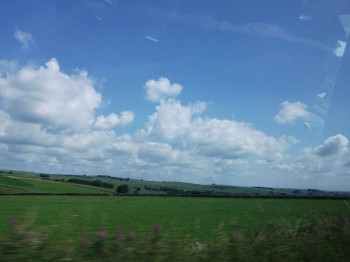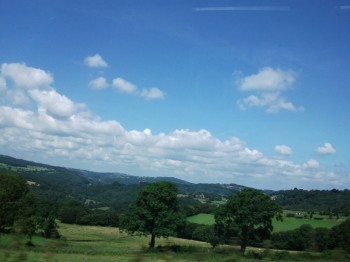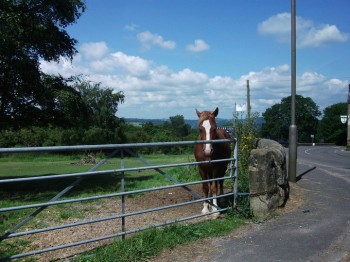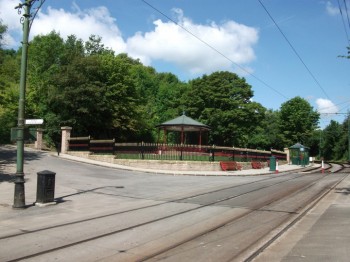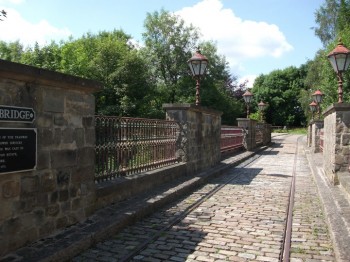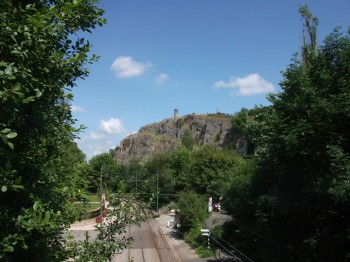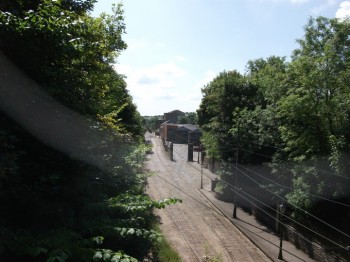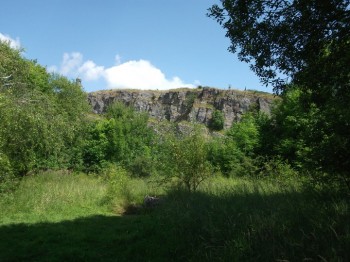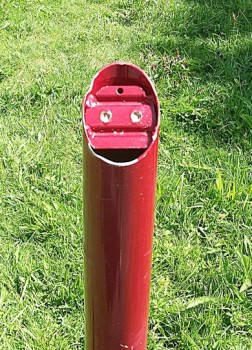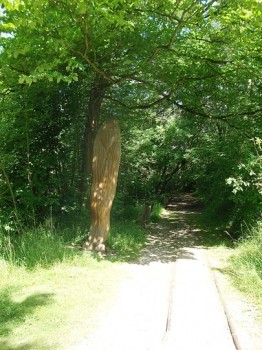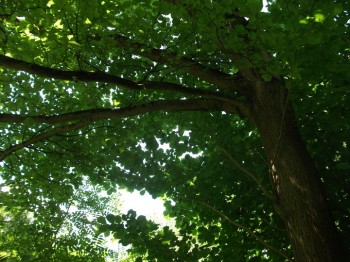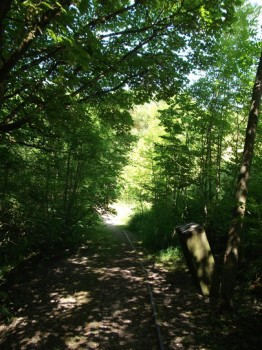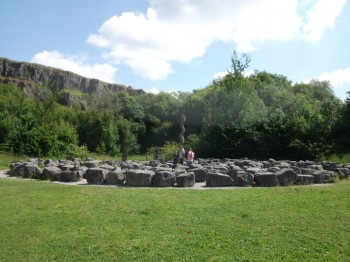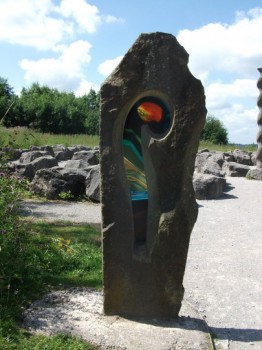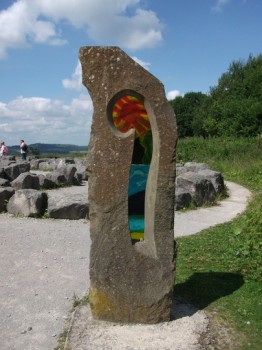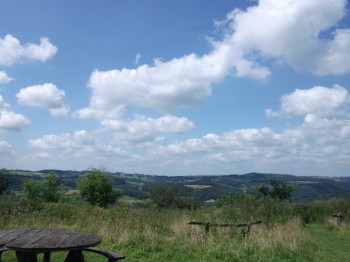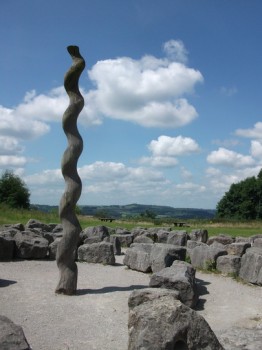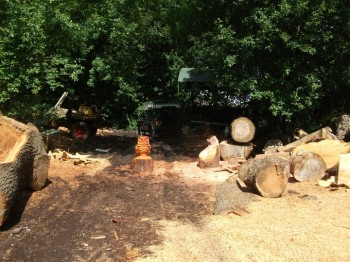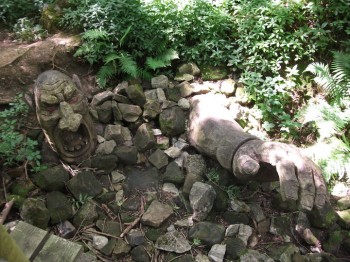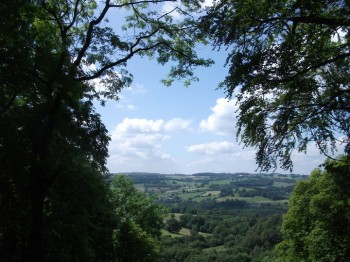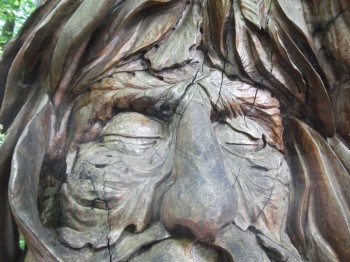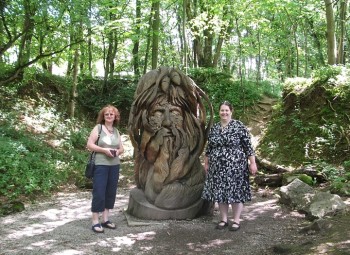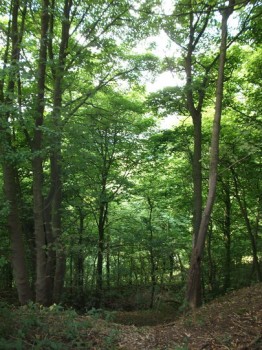Just on the other side of the Peak District is the Crich Tramway Village, home of the National Tramway Museum. From the website: “Nestling on the edge of the Peak District this award-winning museum takes you on a mile-long scenic journey through a period street to open countryside with panoramic views over the Derwent Valley.” Tram enthusiasts started putting it together after a group of them went on a tour to see trams in different parts of the country, and discovered the serious state of decline many tram lines were experiencing. They found the home at Crich in 1959, and right away started buying up trams and storing them under cover.
One day last week, I went with some of the members of Charlesworth WI for a visit. It’s only 40 miles away, but it took an hour and a half each way by private car (we went one way and came back another); the winding, narrow roads of the Peak District really impact speed. (As an aside, Google Maps is generally wrong on travel time by car in England. Sometimes not by much, as here; sometimes vastly so.) Thankfully, the view along the way is of pretty countryside. We set off around 10am and got there about 11:30.
Once we arrived, I split off to wander on my own, because that’s how I like to roll. The village has several attractions, but perusing the map, I saw it basically divided into the Woodland area and the townscape area. The entrance is about in the middle of the village, with the townscape to the left and the woodland to the right.
I took nearly 400 photos on this trip, and while you’re not going to see most of them (I nearly always take duplicates in case of blurring, for starters), there’s still quite a lot. So this entry will be in multiple parts – once it’s done, click here to see all the parts.
-
The Admissions Building – looking back after gaining entry.
Full size image
-
Looking left from the entrance, down towards the town scape.
Full size image
-
Looking right from the entrance: Victoria Park in the foreground; the Woodland behind it. In Victoria Park is an Edwardian bandstand from Longford Park, Stretford, carefully dismantled and rebuilt by a team of volunteers in 1971.
Full size image
I decided to explore the Woodland first, while my feet (which have all sorts of issues that mean that they frequently hurt) were still fresh, and I could get the most out of it. I didn’t realize it would really be quite woodsy – I found myself dearly wishing I’d brought my bug spray!
-
To get to the Woodland, first I crossed over that bridge you just saw. It’s the Bowes-Lyon Bridge, installed at the Bowes-Lyon Estate, Stagenhoe Park, Ware, Hertfordshire in 1844. It was donated to the museum in 1971 and erected by members of the Tramway Museum Society.
Full size image
-
While crossing the bridge, a tram passed underneath.
Full size image
-
A higher view off that side of the bridge.
Full size image
-
Looking the other way off the bridge, we see the tram depot and the glorious sunshine!
Full size image
-
The first bit of woodland we find is a picnic area. It was only about 11:45, so I wasn’t hungry yet for the lunch I’d packed. Shame; this was a pretty area.
Full size image
-
Adjacent to the picnic area was this playground. It was a pretty quiet day in terms of visitors – I think we were ahead of the school summer break for most, and on a weekday.
Full size image
-
There were a few of these wooden huts along the trail.
Full size image
-
This little guy greeted me along the trail. Not sure what the post was doing there, other than providing a way for this smiley face to greet us all. More faces in things.
Full size image
-
The Crich Stand, built in 1923 to replace what was originally built in 1785 (and has been replaced several times since then). The sign said it’s open to the public and you can climb the staircase inside for views across Derbyshire – as far as the towers of Lincoln Cathedral in the east (40 miles) and the summit of the Wrekin, near Shrewsbury (about 60 miles), to the west. I decided to give the hike (which I couldn’t quite tell how to go about starting) a miss this time.
Map of those locations; Full size image
-
The Crich Stand at Crich, Derbyshire, is open to the public and you can climb the staircase inside for views across Derbyshire – as far as the towers of Lincoln Cathedral in the east (40 miles) and the summit of the Wrekin, near Shrewsbury (about 60 miles), to the west.
-
It’s a limestone quarry. Large scale quarrying began in 1793, and has carried on. In 2003, Aggregate Industries, employed 8 people and quarried approximately 300,000 tonnes (660 million pounds). It may still be an active quarry; I can’t find anything online to tell me.
Full size image
-
I saw a butterfly!
Full size image
-
A fish, maybe? Something to point you down this shadier, much cooler side path, anyway. The sun was very hot that day!
Full size image
-
Down that shady path, there were a series of these markers to tell you about the trees and plants on the path. Some were more interesting than others. “Elm wood was once used to make underground water pipes and is still used in wet situations such as harbours.” Nifty!
Full size image
-
Much cooler.
Full size image
-
I almost ran for the end, though, because the bugs had started feasting upon my delightful flesh by now.
Full size image
Then I found a labyrinth!
-
The labyrinth at Crich. The sign said it’s based on a traditional German design with interlocking spirals, which is known as a Wonder Ring. The limestone blocks for the labyrinth were supplied from the quarry in the background of this photo by Aggregate Industries. Martin Heron has carved a helix to provide the focal point of this labyrinth.
Full size image
-
The Crich labyrinth and the Crich Stand.
Full size image
-
Another view of the labyrinth.
Full size image
-
A closer view of the labyrinth, to show the path through it.
Full size image
-
There were two standing stones at the entrance to the labyrinth, designed by Nigel Cann. This darker stone to the south represents the rocks under the ground, showing the strata and fault lines.
Full size image
-
The other standing stone at the entrance to the labyrinth. This lighter stone illustrates the landscape of the Derwent Valley with the river, vegetation, and sky.
Full size image
-
The view of the Derwent Valley beyond the labyrinth. “If you mow your lawn and find a bench … you might be a redneck.” Ahem.
Full size image
-
The labyrinth with the Derwent Valley in the background.
Full size image
-
After leaving the labyrinth, I passed the workshop of the artist of many or all of the wood sculptures along the trail, a chainsaw carver called Andrew Frost. He wasn’t in the office this day, so I just ogled the owl a bit and wandered on.
Full size image
-
Another side path to explore!
Full size image
-
The walkway was covered in chicken wire, I presume to aid traction. Could do with some of this on Glossop High Street, actually.
Full size image
-
Aha, it’s a trail of tree art by Andrew Frost – and here’s the first creation!
Full size image
-
Unleashed from the depths of hell…
That’s quite good, actually; I quite like this piece. 🙂 By Andrew Frost.
Full size image
-
Across the way is another view of the Derwent Valley.
Full size image
-
A closer look at the Derwent Valley.
Full size image
-
A Green Man in his fernery. Carved by Andrew Frost; planted by the Amber Valley Conservation Volunteers. This is a really lovely little grove, and had I not been busily being digested alive by the insect life, I’d have loved to sit here awhile. According to the sign, they chose to have a green man carved for this site because of his theme of life, death, and rebirth connecting to this site, spoiled by quarrying and tipping, now being recolonized by plants and trees, and reborn as the National Tramway Museum and Crich Tramway Village.
Full size image
-
A closer view of the Green Man.
Full size image
-
An even closer view of the Green Man. He’s not looking too good, and it’s only been 10 years since he was installed. I’d love one of these chainsaw carved pieces one day; I will have to do lots of research beforehand to make sure I know how to care for it before I part with any hard-earned!
Full size image
-
I ran into a couple of ladies from my WI along the trail, so we took photos together.
Full size image
-
Having reached the end of the trail, I found another tram stop and another tram. (There was another sculpture you get to miss; it was of a giant wood ant – another chainsaw carving, and the body was six or eight feet long; it was rather frightening. Thought I’d spare you – and myself – that picture.)
Full size image
That was the end of the woodland. It was about 1pm by now, so I was hungry for lunch. There were a couple of picnic tables here at the tram stop, so I decided to stop here and eat. Not the most scenic choice, but it was handy, and quiet, and bug-free as far as I noticed, and I even got a bit of shade.
Right, that’s as good a place as any to stop for now. Stay tuned for the next installments!


